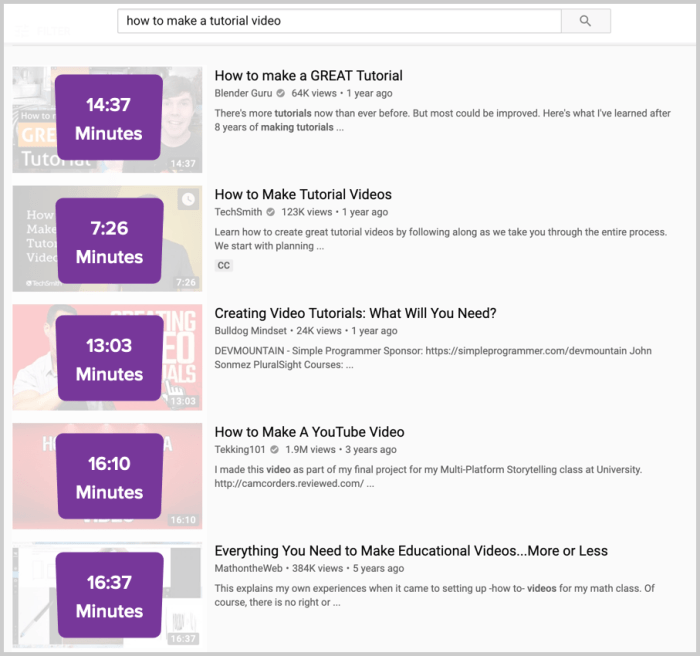Creating How-to Videos kicks off the ultimate guide to crafting engaging instructional content that resonates with viewers. Dive into the world of filming, editing, and promoting your how-to videos with style and finesse.
Introduction to How-to Videos

How-to videos are instructional videos that demonstrate step-by-step processes for completing a task or learning a new skill. They serve as a valuable resource for individuals seeking guidance and practical tips on a wide range of topics.Exploding in popularity across various platforms like YouTube, Instagram, and TikTok, how-to videos offer a visually engaging and easily digestible format for sharing knowledge.
With the rise of short-form video content, how-to videos have become a go-to source for quick tutorials and DIY projects.
Examples of Successful How-to Video Content
- Recipe tutorials showcasing easy-to-follow cooking instructions.
- Beauty tutorials providing makeup tips and skincare routines.
- Home improvement guides offering renovation and repair demonstrations.
- Fitness videos demonstrating workout routines and exercise techniques.
Planning Your How-to Video
When it comes to creating a top-notch how-to video, proper planning is key. Before hitting record, you need to Artikel the steps, create a script, and identify your target audience. Let’s dive into the details.
Importance of Outlining the Steps
Creating an Artikel of the steps you will cover in your how-to video is essential for staying organized and on track. It helps you ensure that you cover all the necessary information in a logical sequence, making it easier for your viewers to follow along.
- Start by brainstorming all the steps involved in the process you are demonstrating.
- Arrange the steps in a clear and sequential order to avoid confusion.
- Include any necessary materials or tools needed for each step.
- Break down complex steps into smaller, more manageable tasks.
Creating a Script or Storyboard
Having a script or storyboard for your how-to video can help you stay on message and ensure that you cover all the important points. It also allows you to visualize how the video will flow and make any necessary adjustments before filming.
Consider writing a script if your video involves a lot of narration or dialogue. For more visual demonstrations, a storyboard may be more appropriate.
- Write a detailed script outlining the dialogue, narration, and actions that will take place in the video.
- Sketch out a storyboard with rough drawings or descriptions of each scene to visualize the video’s flow.
- Include any text that will appear on screen, such as titles, captions, or key points.
- Review and revise your script or storyboard to ensure clarity and coherence.
Identifying the Target Audience
Understanding your target audience is crucial for creating a how-to video that resonates with viewers. By knowing who you are trying to reach, you can tailor your content to their needs, preferences, and level of expertise.
- Research your target audience to determine their demographics, interests, and knowledge level.
- Consider what questions or problems your audience may have that your video can help solve.
- Adapt your language, tone, and examples to suit the preferences of your target audience.
- Solicit feedback from viewers to gauge their reactions and refine your content for future videos.
Equipment and Setup: Creating How-to Videos
When filming how-to videos, having the right equipment and setup is key to achieving high-quality results that engage your audience. Proper lighting, good audio quality, and essential filming gear are essential components to consider.
Essential Equipment
- Camera: Invest in a good quality camera to capture clear and sharp images. A DSLR camera or a smartphone with a high-resolution camera can work well.
- Tripod: Keep your camera steady by using a tripod to avoid shaky footage.
- Microphone: Good audio quality is crucial for your videos. Consider using an external microphone to capture clear sound.
- Backdrop: Choose a clean and clutter-free backdrop to keep the focus on your content.
- Props and Tools: Depending on your how-to video, gather all the necessary props and tools in advance.
Proper Lighting Setup
Lighting plays a vital role in enhancing the visual appeal of your videos. Here’s how to set up proper lighting for filming:
- Use natural light whenever possible by filming near a window or outdoors.
- If natural light is not available, invest in softbox lights or ring lights to create a well-lit environment.
- Avoid harsh shadows by positioning your lights at different angles to achieve a balanced lighting effect.
- Consider the color temperature of your lights to ensure consistent lighting throughout your video.
Importance of Good Audio Quality
Clear and crisp audio is essential for keeping your viewers engaged and ensuring they can follow along with your instructions. Here’s how to achieve good audio quality:
- Use an external microphone close to your mouth to capture clear sound and minimize background noise.
- Avoid filming in noisy environments and choose a quiet location to record your audio.
- Consider using a pop filter to reduce plosive sounds like “p” and “s” for a smoother audio experience.
- Monitor your audio levels while filming to ensure they are not too low or too high, resulting in distortion or muffled sound.
Filming Techniques

Lights, camera, action! When it comes to creating engaging how-to videos, your filming techniques play a crucial role in keeping your audience hooked. From framing shots effectively to maintaining engagement throughout the video, here are some tips to help you level up your filming game.
Tips for Framing Shots Effectively
- Use the rule of thirds: Divide your frame into thirds both horizontally and vertically, and place your subject along the lines or at the intersections for a visually appealing shot.
- Pay attention to the background: Make sure your background is not cluttered or distracting, and ensure it complements your subject without overshadowing it.
- Vary your shots: Mix up close-up, medium, and wide shots to add visual interest and keep your audience engaged.
Importance of Clear and Concise Shots
- Clear and concise shots help your audience follow along easily without getting confused or overwhelmed.
- Avoid shaky footage: Use a tripod or stabilizer to keep your shots steady and professional-looking.
- Focus on your subject: Make sure your subject is well-lit and in focus to draw your viewers’ attention where it needs to be.
Maintaining Engagement Throughout the Video
- Keep it moving: Avoid long, static shots that may bore your viewers. Add movement or transitions to maintain interest.
- Be energetic and enthusiastic: Your passion for the topic will shine through and keep your audience engaged.
- Include interactive elements: Encourage audience participation through polls, quizzes, or calls to action to keep them involved.
Editing and Post-Production
Editing and post-production are crucial steps in creating a polished and professional-looking how-to video. Once you have filmed your content, it’s time to enhance it through editing to make it engaging and informative for your audience.
Editing Software Options
- Beginners can start with free and user-friendly editing software like iMovie (for Mac users) or Shotcut (for PC users).
- For those looking for more advanced features, Adobe Premiere Pro and Final Cut Pro are popular choices, albeit with a steeper learning curve.
Trimming, Transitions, and Text/Graphics
- Trimming: Use the editing software to cut out any unnecessary footage and create a seamless flow in your video.
- Transitions: Add transitions between clips to smoothen the video’s transitions and keep the viewers engaged.
- Text/Graphics: Enhance your video by adding text overlays for instructions or graphics to emphasize key points.
Optimizing for Different Platforms
- Before exporting your video, consider the platform where it will be shared (YouTube, Instagram, etc.) and adjust the resolution and aspect ratio accordingly.
- For social media platforms, ensure the video is optimized for mobile viewing by keeping it short and engaging from the start.
Publishing and Promoting
When it comes to sharing your awesome how-to video with the world, there are a few key strategies to keep in mind. From titling and tagging for to creating an eye-catching thumbnail, here’s how to get your video noticed and shared.
Titling and Tagging for
- Choose a descriptive and -rich title that clearly reflects the content of your video.
- Include relevant s in your video tags to help it show up in search results.
- Research popular search terms related to your video topic and incorporate them into your title and tags.
- Avoid clickbait titles that are misleading or unrelated to the actual content of your video.
Creating an Engaging Thumbnail, Creating How-to Videos
- Select a high-quality image that accurately represents the content of your video.
- Use bold, clear text overlay to highlight the title or key points of your video.
- Choose colors and visuals that grab viewers’ attention and make them want to click on your video.
- Avoid cluttered or confusing thumbnails that may deter viewers from clicking.
Promoting on Social Media and Other Channels
- Share your video across all your social media platforms, including Facebook, Instagram, Twitter, and LinkedIn.
- Engage with your audience by responding to comments, questions, and feedback on your video posts.
- Collaborate with other creators or influencers in your niche to reach a wider audience.
- Consider running paid promotions or ads to boost visibility and reach new viewers.
